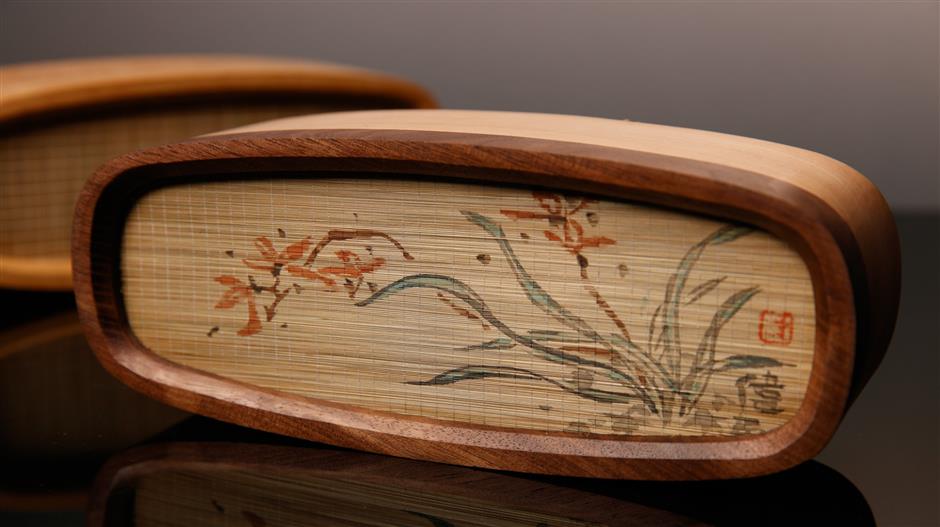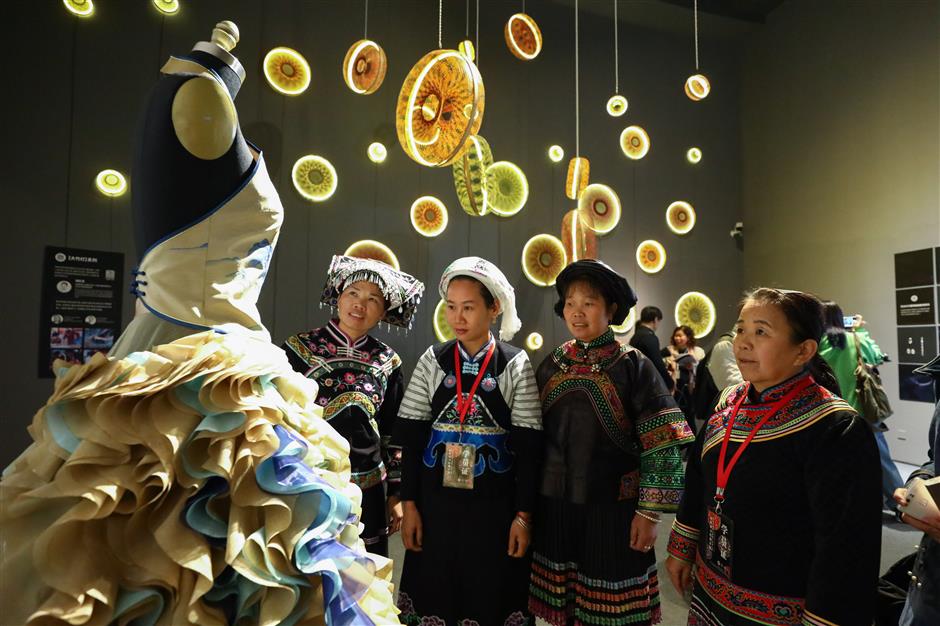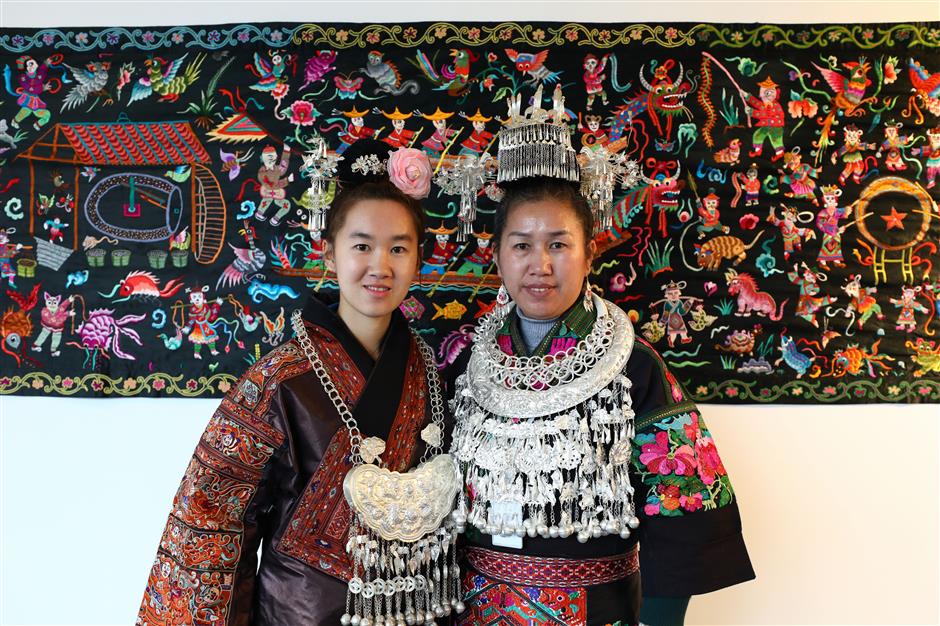Cultural heritage kept relevant by being adapted to modern products

Yang Zaimei (right), a national inheritor of the embroidery of the Miao ethnic minority, explains one of her embroidery works at Shanghai University’s Academy of Fine Arts to her daughter Tai Xinhui, who attends Guizhou Minzu University.
Yang Zaimei, a national master in the ancient embroidery of the Miao ethnic minority, is a busy woman nowadays as China steps up its campaign to promote and perpetuate iconic heritage.
Yang not only teaches apprentices every week, including foreigners, but she also advises a domestic luxury brand on design and embroidery patterns for fashion bags, clothing and shoes.
Her studio, which she operates with her daughter and apprentices, has gained international attention, thanks to an ongoing training program under China's Ministry of Culture.
Under the project, those with inherited traditional skills are sent to study in domestic universities for a month. There, they learn how to adapt ancient talents into modern products that will keep the heritage alive in contemporary society.
About 30 traditional embroidery masters from the Miao and Buyi ethnic minorities attended one of the training sessions at Shanghai University’s Academy of Fine Arts and the Shanghai Institute of Visual Arts earlier this month.
Included in the curriculum were theory of color combinations and practical innovation skills to stretch their imaginations beyond the remote mountainous villages where most of them live.

The traditional embroidery masters from the Miao and Buyi ethnic minorities practice the combination of colors according to the theories taught in a class at Shanghai University’s Academy of Fine Arts.
Since the ministry launched the program in 2015, 78 universities and colleges have participated in classes for 15,000 heritage handicraft masters in disciplines such as bamboo carving, silver jewelry making, mud sculpture and ceramics.
The Shanghai University alone has trained 284 inheritors, said Zhang Lili, associate professor in charge of the classes.
The month-long courses are broken into classes of about 20 masters from similar disciplines. In addition to basic knowledge and discussions of how to bring innovation to ancient skills, industry representatives are invited as guest speakers to talk about how skills can be used in contemporary commerce, Zhang said.
“With that help, many traditional folk arts have been turned into stylish merchandise that is popular with consumers,” she said. “It’s an ideal way to protect these traditional skills from extinction. If inheritors can show profits, more young people in their hometowns will be willing to learn those skills.”
China has listed 1,986 items of national “intangible cultural heritage,” including literature, music, dance, opera, sports, arts, handicrafts, traditional medicine and folk arts. Some are on the verge of being lost forever.
The traditional weaving and dyeing of the Li ethnic minority, for example, is listed as an endangered intangible skill by UNESCO. It is based on a traditional and complicated process of spinning, weaving, dyeing and embroidery.
Eighteen universities involved in the training program staged a recent exhibition of over 280 fashion products melding traditional skills with modern designs.

The traditional embroidery masters are asked to stretch their imaginations beyond their former artworks to create new patterns at a class of Shanghai University’s Academy of Fine Arts.

A Bluetooth speaker jointly created by Mou Jingping and Wang Dawei, executive dean of the Academy of Fine Arts.
Mou Jingping, an inheritor of bamboo-curtain making from the southwestern city of Chongqing, was one of the exhibitors. His traditional skill, which dates back to the Song Dynasty (960-1279), was used to make Bluetooth speakers. He was assisted by Wang Dawei, executive dean of the Academy of Fine Arts, during a month-long course there in 2016.
The speakers are big sellers online because the bamboo curtain improves stunning sound effects, according to Zhang.
In another example of modern adaptation, He Hongbing, a bamboo-weaving master from Zhejiang Province, worked with Dutch designers Yvonne Lauryssen and Erik Mantel to incorporate traditional weaving into European-style modern lamps.
Duan Songwen, a master of Tibetan silver jewelry from northwestern Qinghai Province, attaches his jewels onto French-style leather handbags, applying techniques he learned from artist He Ran during the training classes.

Duan Songwen, a master of Tibetan silver jewelry from northwestern Qinghai Province, attaches his jewels onto French-style leather handbags.
Yang, the Miao embroider, was among the earliest graduates of the national program. At her studio in Guizhou Province, she has formed an “assembly line,” where each embroidery worker is in charge of one part of a product.
Yang is working with Sheme, a Chengdu-based luxury brand, to use traditional embroidery in tailored bags, clothes and shoes. A pair of shoes embroidered with Yang's artwork sells for 6,000 yuan (US$905). Demand from both domestic and foreign customers exceeds supply, she said.
Miao embroidery originated in the ancient tattooing customs of the Pu ethnic minority, dating back to the Shang Dynasty (circa 16th-11th century BC). It features bright colors and vivid geometric patterns that embody ethnic metaphors.
"Few locals were willing to study Miao embroidery because it involves dozens of complicated needle skills,” said Yang, 50, who learned the craft from her mother starting when she was 3 years old. “I think the classes I now give are important to keeping it alive.”

Wang Qin, the inheritor of traditional embroidery of Buyi ethnic minority, studies modern costume designs with other embroidery masters. The exhibition hall at the Shanghai University’s Academy of Fine Arts is decorated with modern lamps jointly created by He Hongbing, a bamboo-weaving master from Zhejiang Province, and Dutch designers.
She counts about 3,000 students from the United States and other foreign nations among her acolytes. With the help of interpreters, Yang teaches both the origin and meaning behind the embroidery and the steps required to master the needlework.
Tai Xinhui, Yang's daughter, is a sophomore from Guizhou Minzu University with a major in digital media and arts. Now she helps her mother design patterns on a computer.
"I am committed to carrying on the traditional skill of my family, which has been inherited for over a dozen generations," Tai said. "I chose to major in digital arts to give the old skill a modern twist.”
However, Yang said some of the traditional spirit of Miao embroidery is being lost in industrial adaptation. Workers in her studio’s "assembly line” lack the depth of feeling that once arose from a craft where it could take a year to complete embroidery for a traditional Miao costume.
"Many followers are embroidering for profit and treating the skill like an industry,” she said. “But true artwork requires a passion embedded deep in the heart.”

Yang Zaimei (right), a national inheritor of the embroidery of the Miao ethnic minority, poses with her daughter Tai Xinhui in front of an artwork of Yang which involves the skills of the Miao embroidery about the scenery of her hometown in Taijiang county, Guizhou Province.















